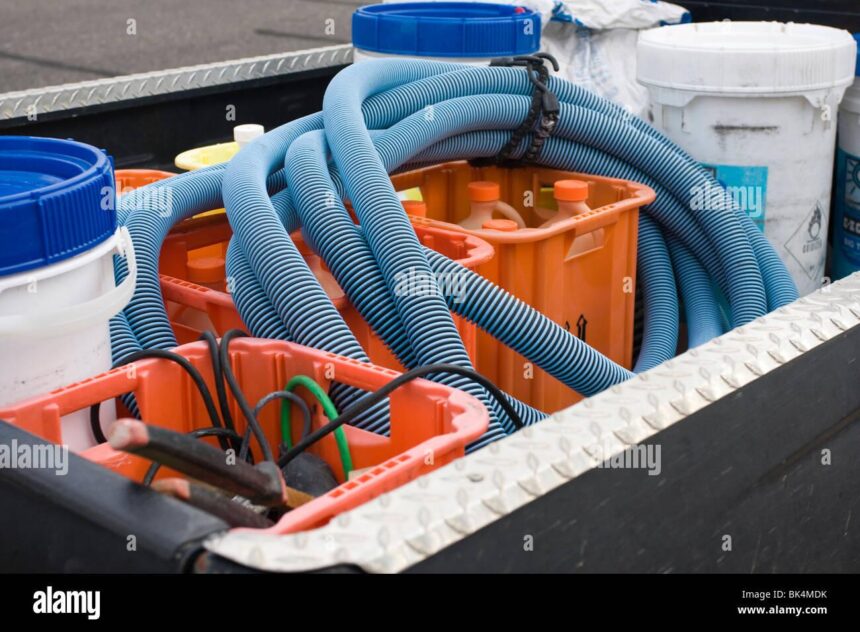A truck carrying pool chemicals overturned Tuesday afternoon in a crash in the central Las Vegas valley, prompting a swift emergency response and temporary road closures. Authorities are investigating the cause of the accident, which raised concerns about potential hazardous material exposure. Traffic was diverted while cleanup crews secured the scene to ensure public safety. Further updates are expected as officials continue their assessment.
Truck Carrying Pool Chemicals Overturns in Central Las Vegas Valley
Emergency responders swiftly arrived at the scene early Tuesday morning after a commercial truck hauling several containers of pool chemicals overturned on a busy roadway in the central Las Vegas valley. Officials promptly cordoned off the area to ensure public safety as hazardous materials teams assessed the potential risks posed by the spilled substances. Traffic was diverted around the incident, causing brief delays on one of the city’s main thoroughfares.
Authorities have confirmed that no serious injuries were reported but emphasize the importance of following safety protocols when transporting dangerous goods. The contents of the truck included:
- Sodium hypochlorite (liquid bleach)
- Calcium hypochlorite (granular disinfectant)
- pH adjusters
Cleanup crews worked through the afternoon to contain the spill and prevent environmental contamination. The Nevada Department of Environmental Protection will continue monitoring the site over the coming days.
Emergency Response and Safety Measures Implemented Following Crash
Immediately after the truck carrying pool chemicals overturned, local emergency crews rushed to the scene, prioritizing public safety and containment of hazardous materials. Firefighters donned full protective gear and deployed specialized foam agents to neutralize potential chemical leaks. The area was swiftly cordoned off,with officers establishing a secure perimeter to prevent unauthorized access and minimize exposure risks to residents and passersby.
Key safety measures implemented included:
- Evacuating nearby buildings within a 300-meter radius
- Shutting down nearby roadways to manage traffic flow and ensure rapid emergency response
- Deploying hazmat teams to monitor air quality and assess contamination
- Coordinating with local hospitals for potential chemical exposure cases
| Response Timing | Units Involved | Status |
|---|---|---|
| Within 10 minutes | Fire & Rescue | On Scene |
| 20 minutes | Hazmat Team | Monitoring |
| 30 minutes | Police Department | Traffic Control |
| 45 minutes | Medical Units | Standby |
Potential Environmental and Health Risks Associated with Chemical Spill
The spill of hazardous pool chemicals following the accident poses meaningful threats to both the environment and public health.These chemicals, often containing chlorine, acids, and stabilizers, can swiftly contaminate nearby soil and water sources, leading to long-lasting ecological damage. Aquatic life is notably vulnerable, with toxic substances causing disruption in aquatic ecosystems, fish kills, and degradation of water quality. Additionally, plants and wildlife inhabiting the surrounding desert terrain may suffer from exposure, resulting in reduced biodiversity and habitat loss.
Health risks for the local population are equally concerning, as exposure to airborne chemical fumes or direct contact can trigger acute symptoms such as respiratory distress, skin irritation, and eye damage. Vulnerable groups, including children, the elderly, and individuals with pre-existing respiratory conditions, face elevated dangers. Emergency responders and cleanup crews must exercise extreme caution due to the corrosive nature of these substances. Below is a summary of primary hazards associated with such chemical spills:
| Risk Type | Potential Impact | Affected Groups |
|---|---|---|
| Environmental Contamination | Soil and water pollution, ecosystem disruption | Local wildlife, aquatic species |
| Airborne Toxicity | Respiratory issues, chemical inhalation hazards | Nearby residents, emergency personnel |
| Physical Contact | Skin burns, eye damage, allergic reactions | First responders, bystanders |
Recommendations for Transporting Hazardous Materials on Urban Roads
Transporting hazardous materials through busy urban areas requires strict adherence to safety protocols to prevent accidents and mitigate risks. Drivers and logistics companies must prioritize route planning that avoids densely populated zones when possible, and schedule deliveries during off-peak hours to reduce exposure to heavy traffic. Additionally, vehicles carrying chemicals should be equipped with appropriate containment systems and emergency spill kits, ensuring rapid response capabilities in the event of an incident.
Essential precautions include:
- Regular vehicle inspections focusing on braking systems and load securement.
- Conducting complete driver training tailored to hazardous material handling.
- Implementation of real-time tracking and dialog systems for continuous monitoring.
- Clear labeling and documentation to aid emergency responders in case of an accident.
| Safety Measure | Benefit |
|---|---|
| Advanced GPS Routing | Minimizes urban exposure |
| Emergency Spill Kits | Facilitates quick containment |
| Driver Hazard Training | Enhances accident prevention |
Future Outlook
Authorities continue to investigate the cause of the crash and assess the environmental impact of the spilled pool chemicals. Cleanup crews remain on site as traffic disruptions persist in the central Las Vegas valley area. Motorists are advised to seek alternate routes and stay tuned to local news for updates on the situation. Officials emphasize the importance of safety precautions when transporting hazardous materials to prevent similar incidents in the future.
